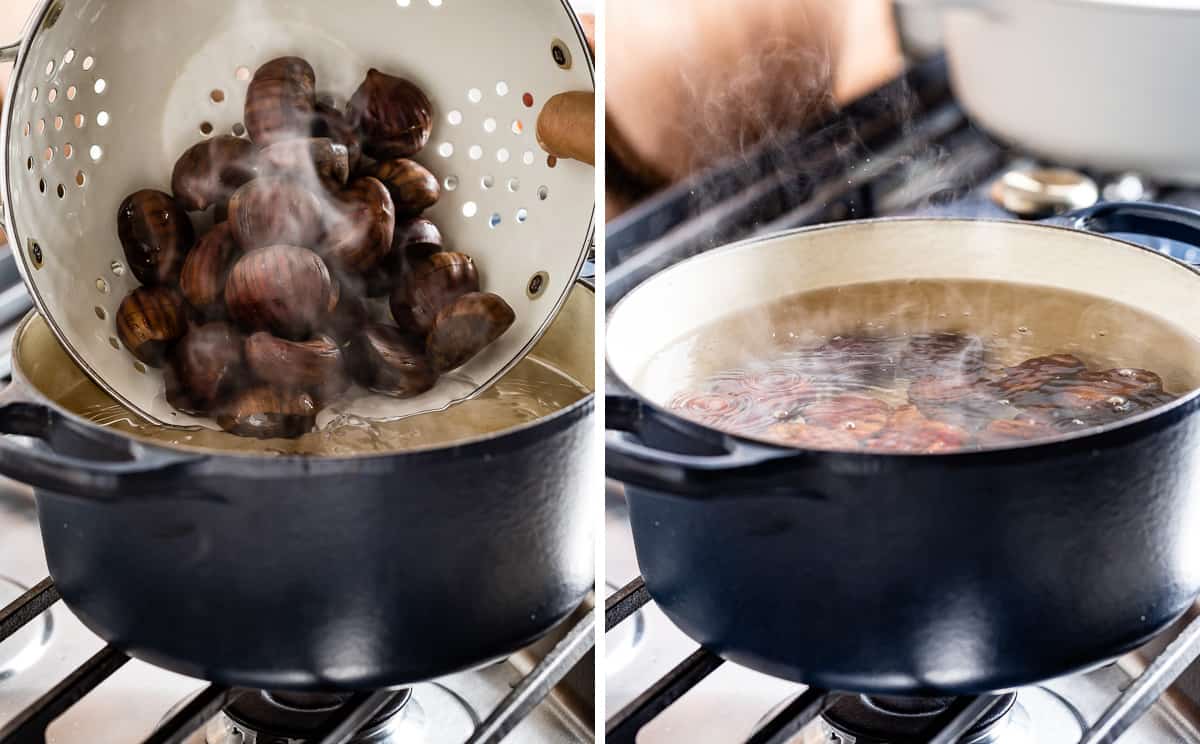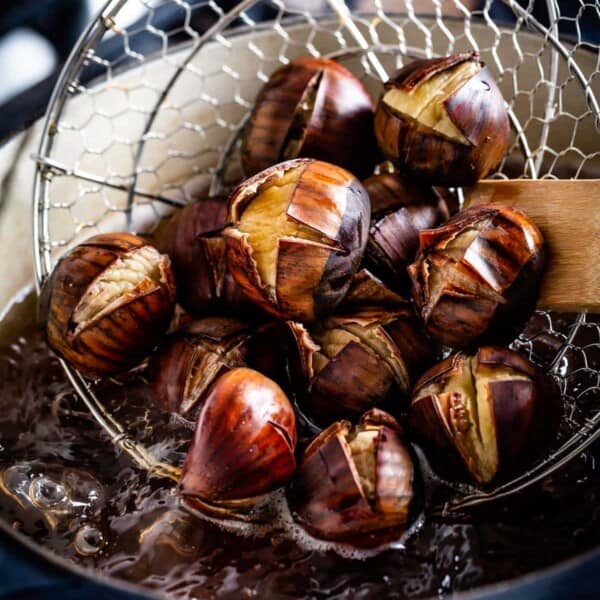New to cooking chestnuts? Be sure to check out our posts on How to Roast Chestnuts in Oven, Air Fryer Chestnuts, and Roasting Chestnuts in an Open Fire.

What You Will Need?
For boiled chestnuts, all you need is raw chestnuts, water, and optional seasonings. However, it is important to note that not all chestnuts are created equal.
- Chestnuts: You can find fresh chestnuts at your local grocery store and farmers markets during the fall and winter months. I tested this steamed chestnuts recipe using Chinese and European chestnuts (primarily from Italy), which are both widely available. Italian chestnuts were easier to peel compared to Chinese ones so I would recommend buying those if you can get your hands on them.
Also, if you can find American chestnuts, they would work as well. - Seasonings: While they are optional, you can flavor the boiling water with bay leaves, orange peel, or cinnamon sticks.
- Water: I used tap water.
Preparing Chestnuts for Boiling:
Start by scoring the chestnuts. This is a crucial step for easy peeling later on.

To do so:
- Place a chestnut on a cutting board, flat side down, securing it firmly in between your index finger and thumb.
- Using a paring knife, chestnut knife, or a sharp serrated knife, make a small incision (approximately ½ inch lengthwise) horizontally over the rounded side of the chestnut. You do want to cut through the outer shell and the inner fuzzy skin, but do your best not to cut through the flesh too much.
How To Boil?
Boiling chestnuts on the stovetop is an easy process and require no special equipment. Simply:

- Boil water in a saucepan: Fill a saucepan with cold water. You should have enough water to cover the chestnuts fully. Bring it to a boil. Place chestnuts into the boiling water and cook for approximately 15-20 minutes, or until the scored section opens up revealing the fuzzy skin on the inside.
- Check for doneness: Carefully remove one chestnut and peel to check if the yellow flesh is fully cooked. If the pulp is soft and creamy, it is cooked.
If so, use a slotted spoon to remove the chestnuts into a bowl. Cover the bowl with a clean kitchen towel and let it cool for 10 minutes. If it is not fully cooked, cook it for another 3-4 minutes, checking doneness during the boiling process once or twice.
How To Peel?
When they are still hot, but somewhat cool enough to handle, peel chestnuts one by one. Start with the outer shell and then remove the inner skin. If you have a hard time removing the fuzzy skin, place it back in the water for a few more minutes or use a paring knife to remove it as much as you can.
For recipes like the famous French Marron Glace (aka candied chestnuts), you would have to peel them slowly so that they will stay in one piece.
Still, peeling chestnuts this way requires patience and you may end up with broken pieces along the way.

Alternatively, you can cut it down the middle and scoop out the nuts using a small spoon and collect the boiled and steamed chestnuts in a bowl. You will end up with broken pieces but it will still be delicious.
I find that this is the easiest way to shell chestnuts, especially if you are using them in a recipe such as chestnut puree (to make Mont Blanc dessert), chestnut stuffing, or chestnut soup.
Discard the bad chestnuts that are spoiled inside as you peel them.
Expert Tips
- It is easier to peel them while they are still warm: During my testing, I learned that boiled chestnuts were easier to peel when they were still warm, especially the fuzzy skin underneath the shell. It was harder to remove the shell after it was cooled down to room temperature. If your chestnuts cool down too much, pop them back in the pot of hot water for 3-4 minutes to rewarm, then drain and continue with peeling.
- Should I add a splash of oil for easy removal?: As I was doing my research for this post, I found a few sources recommending adding a splash of olive oil claiming that it would help with peeling. I did not find this to be helpful at all so I wouldn’t recommend it.
- Be patient: Peeling boiled chestnuts requires patience. It is also important to mention that age and size matter when it comes to cooking time and peeling. If your chestnuts are not equal in size then it might take shorter/longer to cook. As always, check for doneness along the way.
- Use the proper size saucepot: The size of the saucepot and the amount of water you use depends on the amount of chestnuts you are boiling. If you are cooking a lot, then use a large pot and more water.

How To Store, Freeze & Thaw?
- Storage: Place boiled and peeled chestnuts in an airtight container and store in the fridge for up to 4 days.
- Freeze: Place peeled chestnuts in a freezer bag, push out as much air as possible, seal, label, date, and freeze for up to 3 months.
- Thaw: Remove from the freezer and defrost in the fridge overnight.
FAQs
The time it takes for chestnuts to fully cook largely depends on the age and size of the chestnuts. Start by boiling for 15 minutes and check for doneness. If not fully cooked, check for doneness every 5-6 minutes thereafter.
If the outer skin is open revealing the fuzzy skin, you can fish them out. However, it is possible that some of them might not fully open. Because of this, the best way to test doneness is to check one. It is cooked when the inside is soft, with a buttery texture.
Defrost frozen chestnuts in the fridge overnight. Bring to room temperature. Boil them in water for 10-15 minutes or roast them in a preheated 400 degrees F oven for 15-20 minutes. Since cooking time depends on the size and age of the chestnut, be sure to test one before completing the cooking process.
Scoring chestnuts before boiling or roasting helps with removing them from their shells. Once fully cooked, peel the outer layer using the scored shell and then peel away the inner skin. If it is not peeling easily, you can use a sharp paring knife to help you along the way.
Other Snacks You Might Like:
Before I share more snack recipes you might also like please know that I also shared my methods on Roasting Chestnuts in the Oven and Cooking Chestnuts in an open fire so feel free to check those out as well.
If you try this Boiled Chestnuts recipe or any other recipe on Foolproof Living, please take a minute to rate the recipe and leave a comment below. It helps others who are thinking of making the recipe. And if you took some pictures, be sure to share them on Instagram using #foolproofeats so I can share them on my stories.

Boiled Chestnuts Recipe
Ingredients
- 1 lbs chestnuts*, preferably Italian or American chestnuts
- Water
Instructions
- Place chestnuts in a colander and rinse under cold running water. Drain.
- Place the flat side of the chestnut down on a cutting board with the rounded side facing up. Hold the chestnut firmly and using a sharp knife (or a chestnut knife, if you have one) cut it horizontally across the rounded side to make a small incision (about ½ to 1 inch). Turn it 90 degrees and score once again, making an X. As you are cutting, make sure you are cutting through the inner skin without going too much into the yellow flesh. Continue with the rest of the chestnuts.
- Fill a saucepan with water and bring it to a rolling boil. Place the scored chestnuts into the boiling water and cook for 15-20 minutes or until the scored section opens up and the inside of the chestnut is exposed.
- To check doneness, carefully remove one chestnut and peel to check if the yellow nut inside is fully cooked. If it is not fully cooked, cook it for another 3-4 minutes, checking doneness during the boiling process once or twice.
- Do not discard the hot water.
- Using a slotted spoon, transfer boiled chestnuts into a bowl and let them cool for 10 minutes. When still hot, but somewhat cool enough to handle, peel chestnuts one by one first starting with the outer shell and then removing the inner skin. If you have a hard time removing the fuzzy skin, put them back in the hot water for a few more minutes or use a paring knife to remove it as much as you can.
- Alternatively, if it is hard to peel, you can cut it in the middle and remove the flesh using a small spoon and collect the boiled chestnuts in a bowl. You will end up with broken pieces but it will still be delicious.
Notes
- The boiling time and the ease of peeling largely depends on the size, age, and type of your chestnut. This recipe was tested with Italian chestnuts that I hand-picked one by one while making sure that each piece was somewhat equal in size. If your chestnuts are in different sizes, the time of cooking might change. Please check doneness (following my tips) after the first 15 minutes of boiling and cook them longer if need be.
- Boiled chestnuts were easier to peel when they were still warm, especially the fuzzy skin underneath the shell. It was harder to remove the shell after it was cooled down to room temperature. If your chestnuts cool down too much, pop them back in the pot of hot water for 3-4 minutes to rewarm, then drain and continue with peeling.
- Seasonings: While they are optional, you can flavor the boiling water with bay leaves, orange peel, or cinnamon sticks.
Nutrition
Nutrition information is automatically calculated, so should only be used as an approximation.















Hi folks
took me 45 minutes of boiling,,,,,,,,,, not 20.. otherwise it was great.
Thanks for your honest feedback, Richard.
I used your boiling method to cook some chestnuts for stuffing. I was surprised that they were easy to peel too. Next, I’ll try your roasted chestnuts. Thanks for sharing.
Happy to hear that you liked the recipe. Thanks for coming by Sam.